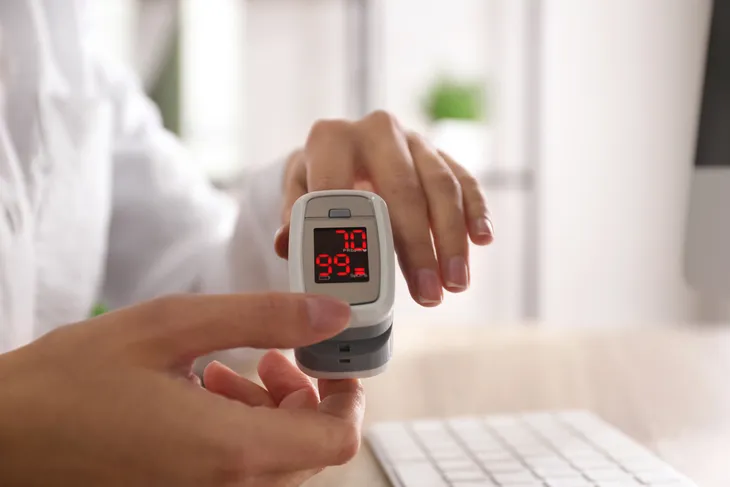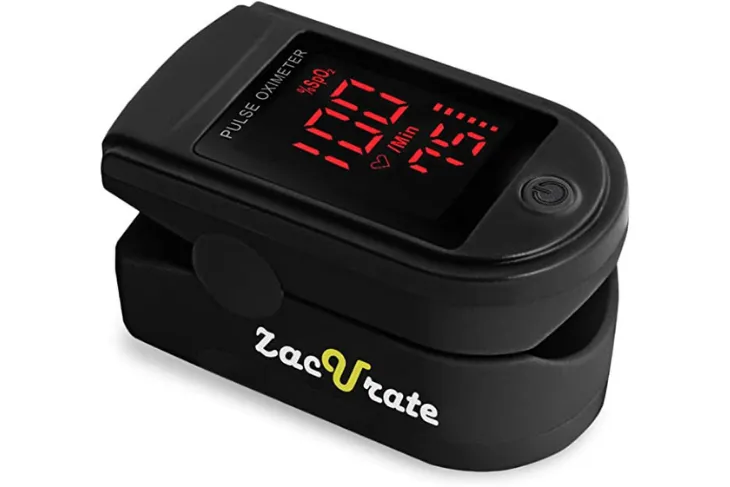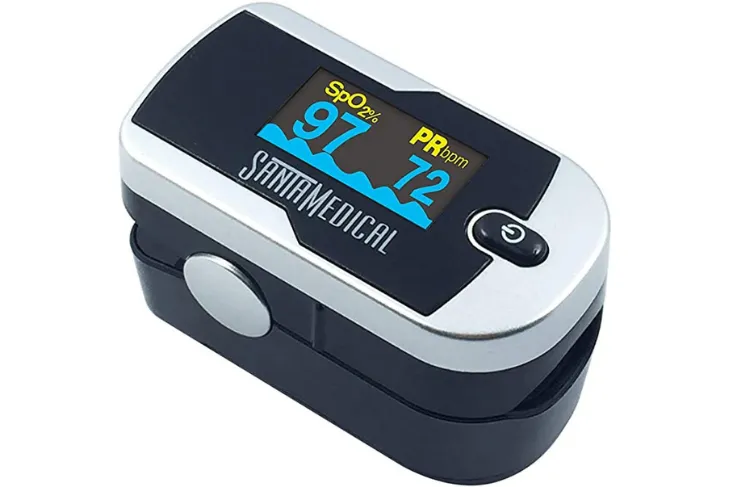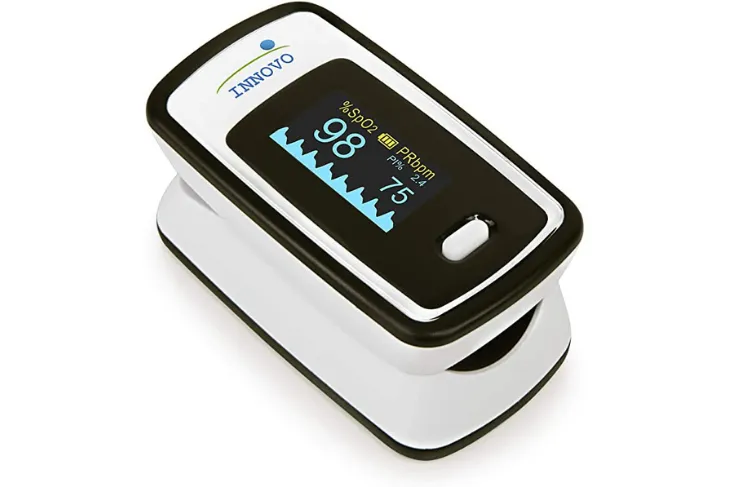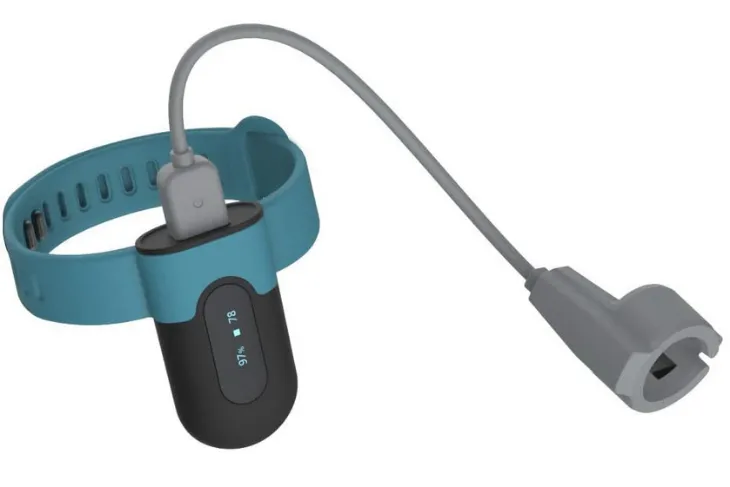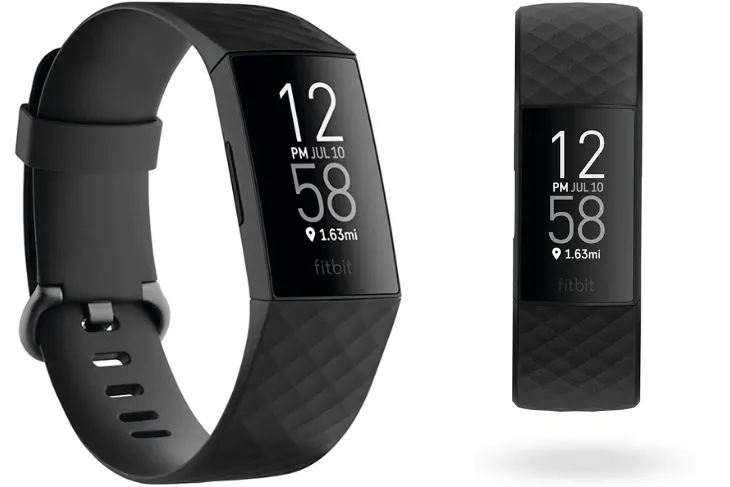A pulse oximeter is likely something most people have never heard of unless they have a condition that requires them to monitor the oxygen levels in their blood. This small medical device is often recommended to people who experience shortness of breath or have a known lung or heart condition. It’s an electronic device that measures the saturation of oxygen carried in the red blood cells, says the American Lung Association.
Pulse oximeters are often used in a hospital setting to help monitor patients, however there are also many at-home options available on the market. To help decide which product is the right choice for you, here’s a breakdown of all the effective pulse oximeters to try and why…
What is a Pulse Oximeter?
A pulse oximeter is a medical device that is used to check how well the heart is pumping oxygen throughout the body. According to Healthline, it is often used by people with specific conditions that affect blood oxygen levels like chronic obstructive pulmonary disease (COPD), asthma, pneumonia, lung cancer, anemia, heart attack (or heart failure), as well as congenital heart defects. Pulse oximeters are often used in the hospital, but they can also be used at home.
Most devices work as a small clamp that is placed on either the finger, earlobe, or toe. “Small beams of light pass through the blood in the finger, measuring the amount of oxygen,” explains Healthline. “It does this by measuring changes of light absorption in oxygenated or deoxygenated blood.” It’s totally painless.
Best Overall: Zacurate ProSeries 500 DL Fingertip Pulse Oximeter
This pulse oximeter has earned the “Amazon Choice” banner which means it’s ranked as one of their best products in that category. The Zacurate ProSeries 500 DL has been adapted to be faster and more consistent. According to Health.com, this new product gave almost 6,000 shoppers a near perfect reading.
It provides a fast reading within 10-seconds and accurate blood level saturation reading within .2-percent deviation of the actual numbers, notes Health.com. (These statistics were provided by lab testing done by the Zacurate brand). It can also do accurate readings in both indoor and outdoor settings, and displays them on an easy-to-read LED screen. “Plus, it provides oxygen saturation levels (SpO2) up to 100-percent, rather than capping the reading at 99-percent like most devices,” writes the source.
Most User-Friendly: SantaMedical Generation 2 Fingertip Pulse Oximeter
Healthline rates this pulse oximeter as the most user-friendly or in their words “best basic or simple pulse oximeter” because it’s easy and efficient. Not only that, but it’s also super affordable making it a good choice for someone who doesn’t necessarily need some of the bells and whistles that come with other products. They just want to know their blood oxygen levels and that’s it.
What is super unique about the SantaMedical Generation 2 Fingertip Pulse Oximeter is that it has an auto shut-off feature that turns it off after 10-seconds. “This oximeter also features only one button for ease of use and requires AAA batteries to power it,” says Dr. Julie Chen when talking to the source.
Best with an Alarm: Innovo Deluxe iP900AP Fingertip Pulse Oximeter (Healthline)
Not surprisingly, the Innovo Deluxe iP9000AP Fingertip Pulse Oximeter comes equipped with an alarm! Don’t worry, it can be muted if needed. Plus, the alarm can be customized six different ways. This auditory alarm helps alert people when their SpO2 and pulse rate goes beyond their limits. It’s a great option for athletes who need to monitor their blood oxygen levels at different altitudes like mountain climbers, skiers, bikers, or any person on the move.
Another big draw to this product is that it’s super affordable at only $24.95 USD through Amazon and it’s ready to use out of the box. All it requires is AAA batteries.
Best Budget: Contec LED CMS50M Pulse Oximeter
The Contec LED CMS50M Pulse Oximeter is by far the most affordable product on this list! It’s available for under $20 USD at $16.95. This makes it a top choice for many consumers. However, there are many other reasons to love this product. It’s super easy to use with a single-button design and is great for all ages.
Just clamp it onto your finger, press the button, and it will start working to compile stats that will then display on the LED screen. It’s battery-operated so it’s travel-friendly and to save power it automatically turns off after 5-seconds. Worried about running out of energy while out and about? A power display on the screen will indicate when battery level is getting low. It takes AAA batteries and according thousands of reviewers on Amazon, it’s great for on the go and earns nearly 5-stars.
Fastest Results: CMS-50 D Plus
Unlike some other pulse oximeters on the market, the CMS-50 D Plus has been cleared by the FDA as a Class II Medical Device which means it can accurately monitor oxygen levels. Equipped with a digital display that shows heart rate and blood oxygen saturation numbers, as well as a fingertip sensor and a bar graph of pulse rates, it’s easy to use at home. VeryWell Health rates it as the pulse oximeter with the “fastest results.”
What makes this product stand out is that it remains accurate at high altitudes making it a top choice for people living in unique climates. It also includes an alarm that will go off if oxygen saturation or pulse rates drop below a pre-set number, as well as a build-in flash memory that records up to 24-hours of data. This can later be uploaded to a computer in order to create a full report to track levels over time.
Best Wrist Pulse Oximeter: Overnight Wrist Oxygen Monitor
Most of the pulse oximeters used at home clamp onto the finger which works great for periodically checking oxygen levels. But this isn’t practical for people who need to monitor for longer periods of time. The Overnight Wrist Oxygen Monitor was developed by Viatom to be comfortably worn on the wrist for hours. It can read oxygenation and heart rate levels over a period of 16-hours thanks to a sensor ring that slips around one finger.
Not surprisingly, this product is considered quite high tech as it can be paired to a smartphone or computer to store, analyze, and display data over a period of time. This is great for tracking trends or when working closely with a doctor as the information can be saved and stored to share at appointments. It’s an ideal option for tracking long-term health conditions.
Best Watch: Fitbit Charge 4
Fitness trackers have become quite popular in the past few years. And for good reason! They’re a great way to promote and encourage movement throughout the day. Over time, they’ve evolved to include features like a digital watch, count steps, heart rate monitoring, and even recording sleep patterns.
The new Fitbit Charge 4 can also calculate an estimate on oxygen variation in a person’s blood through built-in red and infrared sensors that work similar to a pulse oximeter. The Fitbit stores this data in the sleep app indicating either small or large variations. It also has a built-in GPS, heart rate monitoring, and activity tracking.
Best for Kids: Hopkins Handheld Pulse Oximeter
Most medical devices aren’t exactly kid-friendly which misses the mark because kids are not exempt medical conditions! Children are just as prone to developing conditions that can affect their blood oxygen levels so they need to be easily accessible and usable for kids.
The Hopkins Handheld Pulse Oximeter is rated by Healthline as the best for children because it works simply by placing in the palms or soles of children. The only downside of this pulse oximeter is that they are more expensive than other products that can be used on the fingers and toes.
Best Ring: Wellue O2 Ring
Most of the pulse oximeters we’ve shown on this list are the easy to use clamp on the finger (with the exception of the wrist product), however a study published in Clinical and Experimental Hypertension confirmed that ring-shaped pulse oximeters provide just as accurate of a reading as a standard one and VeryWell Health ranks the Wellue O2 Ring as one of the best ring options.
The biggest draw to this product is that it’s easier to use for monitoring during sleep. This is important for people with sleep apnea or COPD, conditions where doctors need to monitor oxygen levels overnight. The ring remains in place better than the clamp option. The Wellue O2 Ring should never replace a CPAP machine, but rather be used in addition to one.
It also has a vibrating alert system which is a much more pleasant way to wake up than most other alarms. It’s also bluetooth compatible, connects to an app, and can be customized to specific levels. You can share reports with others (i.e. doctor) and get accurate and reliable readings. The only downside is that it comes with a hefty price tag of about $180 USD.

